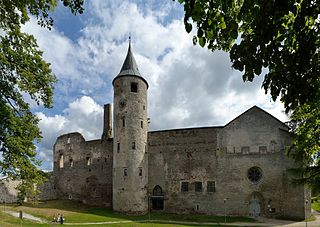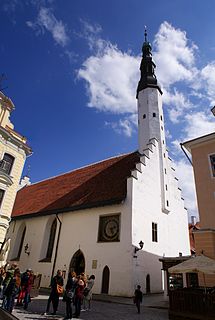
Christian Ackermann was a sculptor and carver who worked in Estonia.

Christian Ackermann was a sculptor and carver who worked in Estonia.

Christian Ackermann was born in Königsberg. [2] He worked in Riga, Stockholm, and Gdańsk, before becoming active in Tallinn from about 1672 until his death in 1710. [3] In 1675, Ackermann moved to Tallinn and worked first in the workshop of Elert Thiele, a local woodcarver. After Thiele's death in 1674, Achermann married the master's widow. He then became a citizen of Tallinn but didn't join the local guild of woodcarvers. And that was a reason why between him and the guild's masters had begun a strong struggle which finished in court. Ackermann won and got the permission to work alone, he was the first independent sculptor in Estonia [4] and acquired his own workshop at Toompea Hill. He probably died either in 1710 or a short time later from plague.
Christian Ackermann was one of the greatest masters of the Baroque style in Estonia. He brought strong Central European influences to Northeast Europe, in particular the motifs of the Baroque and masterful Acanthus ornaments. The majority of his works consists of almost twenty altarpieces, pulpits and large coat-of-arms epitaphs.


St. Mary's Cathedral, Tallinn is a cathedral church located on Toompea Hill in Tallinn, Estonia. Originally established by Danes in the 13th century, it is the oldest church in Tallinn and mainland Estonia. It is also the only building in Toompea which survived a 17th-century fire.

Türi is a town in Järva County, Estonia. It is the administrative centre of Türi Parish. Since 2000, Türi is known as the "spring capital" of Estonia. It has a railway station on the Tallinn - Viljandi railway line operated by Elron.

Haapsalu Castle is a castle with cathedral in Haapsalu, Estonia, founded in the thirteenth century as the seat of the Bishopric of Ösel-Wiek. According to legend, during full moons in August, an image of a maiden, The White Lady, appears on the inner wall of the chapel.

St James's Cathedral is the Roman Catholic cathedral of Riga in Latvia. The cathedral is dedicated to Saint James the Greater. The building is part of the Old Riga UNESCO World Heritage Site and lies directly opposite the House of the Livonian Noble Corporation, the meeting place of Latvia's parliament the Saeima.
Hermen Rode was a German Gothic painter.

Pieter Verbrugghen I was a Flemish sculptor from the Baroque.

St. Nicholas Church is a medieval church building in Tallinn (Reval), Estonia. It was dedicated to Saint Nicholas, the patron of the fishermen and sailors. Originally built in the 13th century, it was partially destroyed in the Soviet bombing of Tallinn in World War II. The building itself has since been restored, however, as a church without own congregation, it has not been used for regular religious activities since World War II. At present it houses the Niguliste Museum, a branch of the Art Museum of Estonia, focusing mainly on ecclesiastical art from the Middle Ages onward. It is also used as a concert hall.
This article covers the architecture of Estonia.

Püha is a village in Saaremaa Parish, Saare County in western Estonia.

Vår Frue Church is a medieval parish church of the Church of Norway in Trondheim municipality in Trøndelag county, Norway. It is located in the downtown Midtbyen area of the city of Trondheim, just a few blocks north of the Nidaros Cathedral. It is one of the two churches for the Nidaros og Vår Frue parish which is part of the Nidaros domprosti (arch-deanery) in the Diocese of Nidaros. The gray, stone church was built in a long church design in the late 1100s using plans drawn up by Bjørn Sigvardsson. The church seats about 540 people.

Tønsberg Cathedral is a Lutheran church located in Tønsberg, Norway. It is the episcopal seat of the Diocese of Tunsberg within the Church of Norway. Originally a parish church, it was elevated to cathedral status in 1948 when the Diocese of Tunsberg was created, detached from the Diocese of Oslo. The cathedral has space for 550 seats.

St. John's Church is a large Lutheran parish church in Tallinn, Estonia. It is dedicated to Saint John the Evangelist, a disciple of Jesus Christ and author of the fourth Christian Gospel. Construction began in 1862, and the church was opened in 1867.

Hendrik Frans Verbrugghen or Hendrik Frans Verbruggen was a Flemish sculptor and draftsman, who is best known for his Baroque church furniture in various Belgian churches.

Undløse Church is located in the village of Undløse some 17 km (11 mi) southwest of Holbæk in northern Zealand, Denmark. The original part of the Romanesque church derives from the late 12th century. The church is noted for its early 15th-century frescoes and for its elaborate Baroque altarpiece and pulpit, both woodcuts by Abel Schrøder.

The Church of the Holy Ghost or Church of the Holy Spirit is a medieval Lutheran church in the old town district of Tallinn, Estonia. It is located behind Raekoja plats, and lies opposite the Great Guild and Maiasmokk, Tallinn's oldest café.

St. Michael's Church or St. Michael's Swedish Church is a Lutheran church used by the Swedish congregation in the old town district of Tallinn, Estonia.

Charles's Church is a Lutheran church in Tallinn, Estonia, built 1862–1870 to plans by Otto Pius Hippius. It is Tallinn's grandest 19th-century church.
Ludwig Münstermann was a German sculptor and master woodcarver from either Hamburg or Bremen. He worked in numerous churches and was a leading exponent of the North German Mannerist style in sculpture.

Tobias Heinze was an Estonian cabinetmaker and woodcarver based in Tallinn.

Lodewijk Willemsens or Ludovicus Willemsens (1630–1702) was a Flemish sculptor from Antwerp. His works comprise mostly sculptured church furniture, and to a lesser extent individual sculptures, both portrait busts as well as statues of saints for churches.
| Wikimedia Commons has media related to Christian Ackermann . |